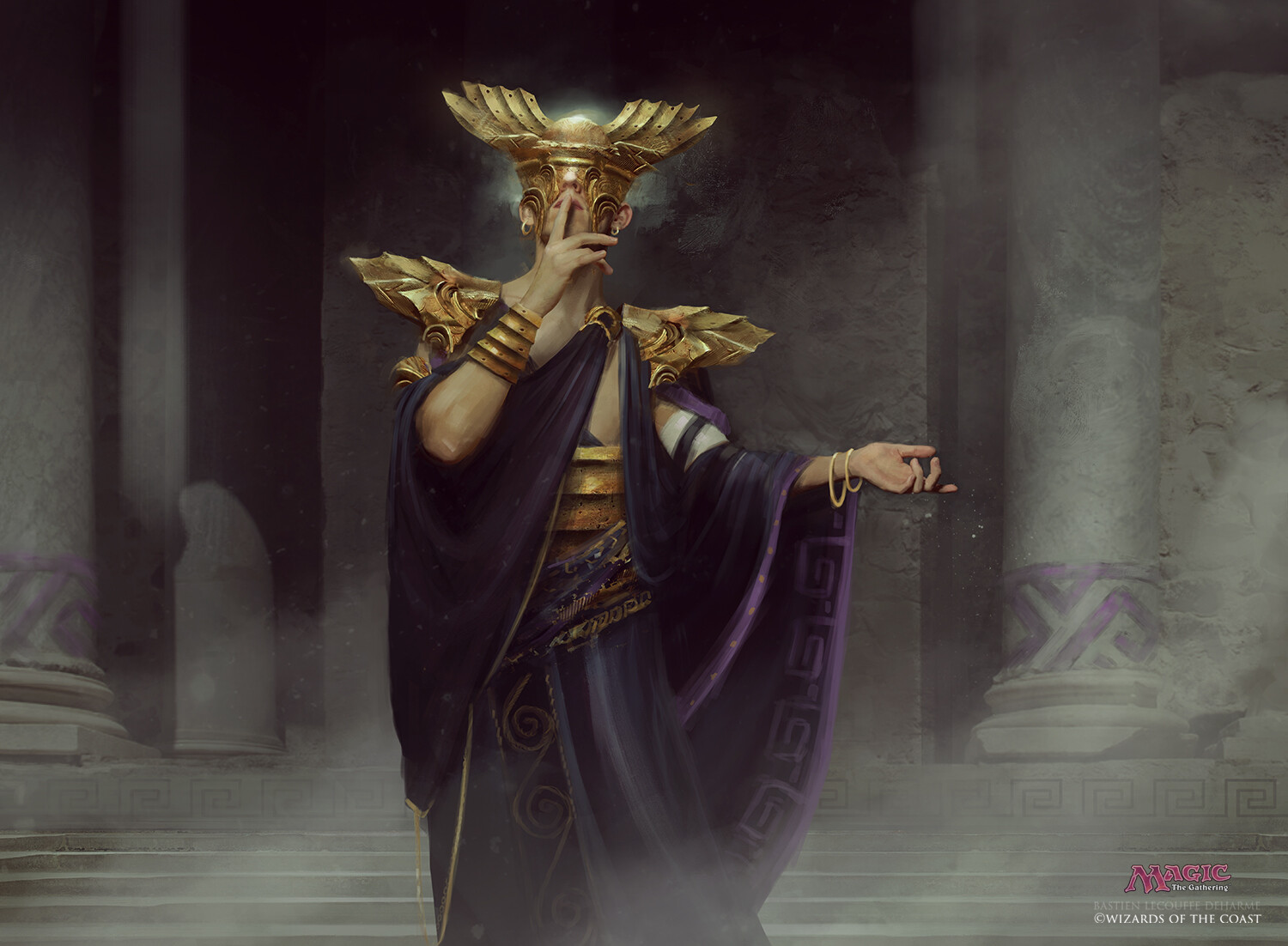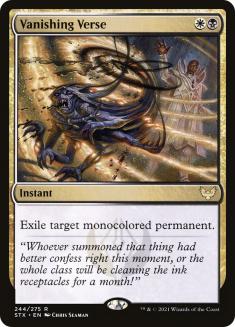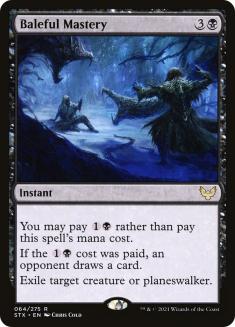With the infusion of Strixhaven, deckbuilders are beginning to finalize their first attempts at a new Standard format. Deciding what new cards to add is one thing; however, the expected changes to the metagame are arguably the bigger problem to solve. Identifying which existing decks get a boost is vital in editing our control lists accordingly. The success of control is largely dependent on the ratio of removal to advantage and blue disruption. The more aggressive a format is, the more traditional removal control decks need to compete. If the spells are strong enough to rise to the challenge against an aggressive metagame, we all rejoice given control’s viability.
A different scenario is the current world we live in, where there are strong aggro elements but the more ferocious matchups are elsewhere. Temur Adventures (with and without Obosh), Sultai Ramp (Yorion), and Dimir Rogues (Lurrus) ran the streets of Kaldheim Standard, making this metagame one of the most hostile for control decks in recent history.
Temur Adventures, even without Lucky Clover, is not a breeze. Most control decks I have built in the last few months have done fine against it, but that still left me bruised with a 50-60% win rate at the end. Edgewall Innkeeper is a must-kill that requires opening-hand removal. Even when that occurs, there are some games that The Great Henge run away with, ones that I thought were in the bag before it resolved. I prefer to see this matchup over the other two, but it’s not the usual midrange bye control is used to.
Sultai Ramp and Dimir Rogues are the matchups that require a very different set of cards to beat. This is where control deckbuilding gets very difficult, and the wrong decisions can derail any competitive endeavor. Sultai Ramp has very few targets for traditional creature removal and the inclusion of Strixhaven is not going to change that. It’s a deck fully comprised of haymakers that all must be countered, or things get out of hand very quickly.
Luckily for us, these Sultai Ramp decks have a pile of dead removal as well. There were some cards from Strixhaven, like Callous Bloodmage and Sedgemoor Witch, that I wanted to play in the maindeck right from the start. Even though both creatures can create advantage before being taken out, the three mana lost is not worth it Game 1. My initial control builds get a bit creative with creatures in the sideboard, but we do not have the luxury of having multiple duds Game 1. There’s no Emergent Ultimatum to save us when the initial spells fall flat in the early-game, making these decisions that much more important.
Dimir Rogues is the last deck of the trifecta that I’m most worried about when updating a control deck with Strixhaven. The most successful control decks in Standard have solidified around Yorion, Sky Nomad, which luckily adds a level of resistance to this matchup. Having twenty more cards in the maindeck is enough to get a few percentage points back to the win rate and provides us with the powerful companion. I wrote extensively in the past that Yorion will not be weakened enough by the rule change. If it and Dimir Rogues are around, I feel obligated to make it the captain of any control ship I pilot.
Building a control deck to beat Dimir Rogues is the toughest task because it requires a significant amount of removal to stave off the early pressure and a late-game Negate to stop Into the Story. Stopping the early pressure, which primarily arrives at instant speed, is only half the solution. Dimir Rogues draws its strength from its card advantage, which it finds from Of One Mind and Into the Story.
Agadeem’s Awakening and Lurrus of the Dream-Den can cause a headache; however, it’s the actual card draw that produces Drown in the Loch, Disdainful Stroke, Mystical Dispute, Negate, and any other disruption that they decide to toss in that week. Having the perfect mix of removal and blue-based disruption is the key to beating this deck. Balancing that ratio, while also drawing the correct removal half against Temur Adventures (or random aggro decks like Mono-White Aggro❄) and the correct disruption half against Sultai Ramp, is the complicated key to victory.
Identifying the best decks in the current Standard while a new set is about to drop is not what I typically spend most of my time doing. When new sets emerge, it’s obvious which cards are being pushed and what new threats control will have to face. With Strixhaven, the picture is not clear, and I’m predicting a weak impact on the current best decks. There are some decent options for control, but even I’m experimenting on a few cards. There’s nothing that just screams “revolutionary” here, outside of Vanishing Verse.
Vanishing Verse will see play in the older formats, but until there’s an Orzhov deck that can house it, it will collect dust. My diehard Esper Control soul tried to force a third color into this Dimir Control deck, just to get this powerful instant quickly into Standard. There are some other advantages of having a third color; however, I want to see how the format shapes up first. I wanted my first control deck of Strixhaven Standard to be as consistent as possible, focusing on the predictably stagnant metagame and maximizing its chances with better mana. If it becomes obvious that Vanishing Verse is needed, then the third-color gamble begins.
Creatures (3)
Planeswalkers (6)
Lands (25)
Spells (46)

This Dimir Control (Yorion) deck is built with a chunk of Strixhaven cards. I’m not completely sold on these, but each has some upside on its competitors depending on the expected matchups that we will face in Strixhaven Standard. Reject may not defeat Essence Scatter in the end, nor Baleful Mastery its Murderous Rider competitor. Time and testing will be the final judge in these bouts, but we can make educated guesses in the meantime.
Reject is the blue disruption spell that got immediate traction on social media, yet I was initially skeptical. Essence Scatter is such a strong late-game card, even against the cheaper creatures that can still cause serious damage. There’s a reason why Mana Leak is not a four-of in Modern control decks. Control decks, especially Standard ones, need absolute disruption to tango with the ever-growing power level of new creatures.
Cards like Spell Piece will never be as good as Negate in Standard control decks, which is where my mind was with Reject. If it only targeted creatures, even though it exiles, there would be no discussion. Since it hits planeswalkers too, Reject becomes more flexible by definition. With Strixhaven revealing very few planeswalker options for the biggest decks of the format, the debate between the two is too close to call. I’m going to start off with Reject out of respect for exiling an early, countered creature, but switching back is a strong possibility.
This control deck does not have any shortage of card advantage, even without Mazemind Tome. I love the two-mana artifact and know how strong it is; however, I do not think it’s necessary in control decks. With Omen of the Sea and Behold the Multiverse as stock four-ofs, additional card draw is not where I want to dedicate more slots.
Most Dimir Control (Yorion) decks I have seen in passing cannot let go of this and I wish we lived in a world where it was needed. Out of the three decks I mentioned, only one calls for a heavy dose of slow, incremental card advantage that takes up a significant amount of mana. Even outside of those three, dropping one onto the battlefield, instead of using that mana for some immediate impact, is a death sentence. When you have Yorion, leave the card draw to the must-have blue spells until your metagame is nonstop mirror matches.
Baleful Mastery is a stronger card in Dimir Control (Yorion) than the traditional planeswalker removal. This, along with a few more impactful spells, replaced Mazemind Tome. Even though there are very few planeswalkers amongst the top decks, many control lists aren’t playing dedicated removal for them. If a late-game planeswalker resolves, regardless of the matchup, the chance of victory sharply declines if it remains on the battlefield.
It’s too risky to depend on Ugin, the Spirit Dragon to handle all the workload, so Baleful Mastery comes in. This could be Murderous Rider, but I like the Strixhaven card wins here. Giving the opponent a free card never feels good, even if barely felt. But just like with Shatter the Sky, Baleful Mastery will handle something monstrous and a cantrip will be the least of your worries. Shatter the Sky was an amazing card for white-based control decks when it came out and it became even more impressive over time. The lost card was a small price to pay for that type of effect, which is how I feel about Baleful Mastery. It will often be used in its four-mana form, but when a multi-spell turn is required, it will shine in Dimir Control (Yorion).
Dimir Control (Yorion) got a few high-impact cards to test out with the release of Strixhaven. Professor Onyx is the obvious addition, adding another high-impact planeswalker to the mix. It enters the battlefield between Ashiok, Nightmare Muse and Ugin, doing the usual planeswalker things. It draws the best card of the top three or deals with the biggest opposing creature the turn it arrives, while having a static ability that I adore. With each instant or sorcery spell, Professor Onyx drains the opponent for two life, giving Dimir Control (Yorion) an easy outlet for lifegain that it lacked. Cling to Dust is wonderful, but it will not swing a game like this planeswalker can.
The ultimate ability of Professor Onyx is a bit odd, likely killing the opponent that’s low on cards, but easy to execute. It has six loyalty after it arrives and draws a card, making it a must-answer before the opponent gets buried under card advantage, losing a bunch of life while you gain, and then ultimately discarding their entire hand with some damage attached. This card is not as much as a gamble as the others, and it will be a staple of black-based control decks if they remain competitive.
Multiple Choice, Sedgemoor Witch, and non-listed Callous Bloodmage are cards that I believe have a role in a Dimir Control (Yorion) deck. Callous Bloodmage did not make the final cut, but it was close. Just like Charming Prince, Callous Bloodmage has some decent battlefield interaction for the mana invested. This one costs three, but it does offer actual card draw, an additional creature, or the ability to exile a graveyard. These attributes make it an ally of Yorion, but its general strength in the control deck is weak. Each card in this deck must be standalone strong and Callous Bloodmage barely misses the mark. If the metagame becomes more graveyard-based, or where a couple of weak blockers are great, it will be right back in the mix. Cards like this, formerly Solemn Simulacrum in this spot, are a bit low on the impact scale to be utilized here.
Multiple Choice and Sedgemoor Witch did make the cut, one in the maindeck and the other in the sideboard. Multiple Choice has some overcosted abilities, but the combination of all of them for five mana provides that necessary payoff to get it on the team. It will mainly serve a role in the early-game, drawing a card to continue to hit land drops. It’s yet another reason why Mazemind Tome is not needed here and offers some assistance against aggro decks to boot. Multiple Choice can return a threat, make a 4/4, or do both while drawing a card. I’m not convinced that it’s good enough against the top decks of Standard, but it does have the flexibility that has made perceived weak cards of the past shine at the end.
Sedgemoor Witch is the Standard version of Monastery Mentor, in a slightly weaker form. The ward ability is not exciting, but magecraft makes it a scary sideboard card for unsuspecting opponents. Control decks have historically stolen matchups by bringing in creatures in the sideboarded games, while the opponent drops their removal. This strategy is as old as the game itself, but it continues to be effective in all the competitive formats I play. Even when the opponent is aware of a couple of incoming, cheap threats, they still must cut removal to fit their own disruption or control-specific sideboard cards.
I’m excited to see these new cards in action and their impact on Standard control.




